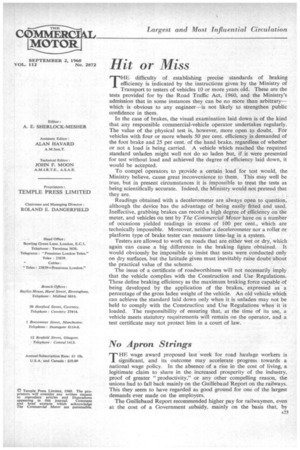Hit or Miss T HE difficulty of establishing precise standards of
Page 25

If you've noticed an error in this article please click here to report it so we can fix it.
braking efficiency is indicated by the instructions given by the Ministry of Transport to testers of vehicles 10 or more years old. These are the tests provided for by the Road Traffic Act, 1960, and the Ministry's admission that in some instances they can be no more than arbitrary— which is obvious to any engineer—is not likely to strengthen public confidence in them.
In the case Of brakes, the visual examination laid down is of the kind that any responsible commercial-vehicle operator undertakes regularly. The value of the physical test is, however, more open to doubt. FOr vehicles with four or more wheels 50 per cent, efficiency is demanded of the foot brake and 25 per cent, of the hand brake, regardless of whether or not a load is being carried. A vehicle which reached the required standard unladen might well not do so laden but, if it were presented for test without load and achieved the degree of efficiency laid down, it would be accepted.
To compel operators to provide a certain load for test would, the Ministry believe, cause great inconvenience to them. This may well be true, but in present circumstances it is impossible to treat the tests as being scientifically accurate. Indeed, the Ministry would not pretend that they are.
Readings obtained with a decelerorneter are always open to question, although the device has the advantage of being easily fitted and used. Ineffective, grabbing brakes can record a high degree of efficiency On the meter, and vehicles on test by The Commercial Motor have on a number of occasions yielded readings in excess of 100 per cent., which are technically impossible. Moreover, neither a decelerometer nor a roller or platform type of brake tester can measure time-lag in a system.
Testers are allowed to work on roads that are either wet or dry, which again can cause a big difference in the braking figlire obtaine.d. It would obviously be impossible to insist that tests were conducted only on dry surfaces, but the latitude given must inevitably raise doubt about the practical value of the scheme.
The issue of a certificate of roadworthiness will not necessarily imply that the vehicle complies with the Construction and Use Regulations. These define braking efficiency as the maximum braking force capable of being developed by the application of the brakes, expressed as a percentage of the gross laden weight of the vehicle. An old vehicle which can achieve the standard laid down only when it is unladen may not be held to comply with the Construction and Use Regulations when it is loaded. The responsibility of ensuring that, at the time of its use, a vehicle meets statutory requirements will remain on the operator, and a test certificate may not protect him in a court of law.








































































































